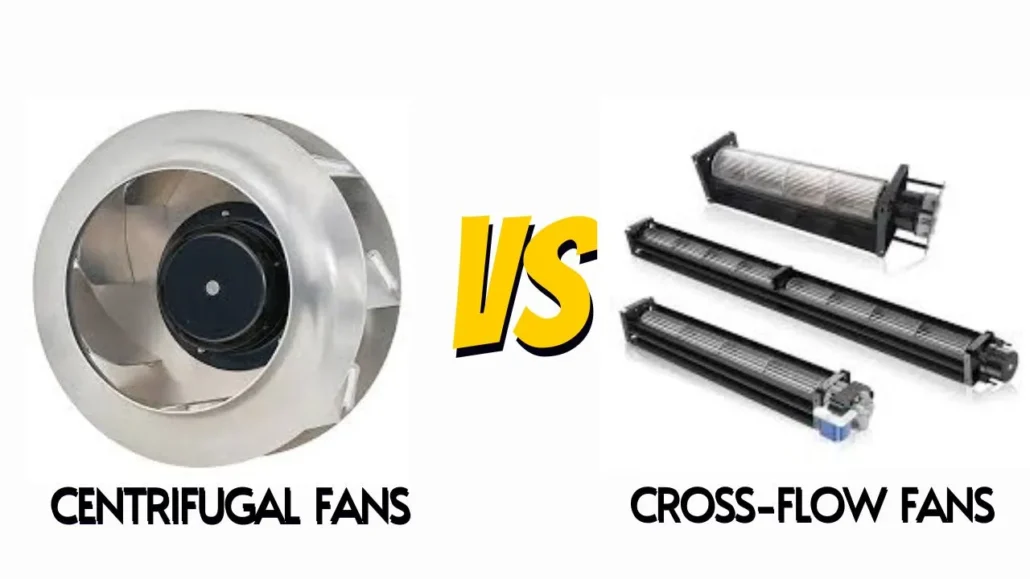
With regards to picking the right fan for your cooling or ventilation needs, understanding the distinctions between centrifugal fans vs cross flow fans is pivotal. The two kinds of fans have extraordinary designs, working standards, and applications, making them the perfect choice for various purposes. Industrial and HVAC systems frequently use centrifugal fans, renowned for their high-pressure capabilities and effectiveness. Conversely, cross-flow fans give uniform air currents and are often found in applications requiring even air dissemination, such as air draperies and electronic cooling. To assist you in making an informed decision, we will examine the primary distinctions between cross-flow fans and centrifugal fans in this guide, highlighting their advantages, disadvantages, and typical applications.
Table of Contents
ToggleCentrifugal Fans
Centrifugal fans, also called radial fans, are mechanical gadgets that move air or gases toward a path opposite the approaching air current. And these fans are broadly utilized in different modern and business applications. Because of their capacity to produce high tension and keep wind stream over lengthy distances.
Design and Structure of Centrifugal Fans
Centrifugal fans ordinarily comprise of some fundamental parts:
- Impeller: A pivoting circle with numerous blades/edges or vanes that attract air or gas.
- Housing: A nook that coordinates the progression of air or gas into and out of the impeller. It is typically molded like a parchment or volute to upgrade airflow effectiveness.
- Inlet and Outlet: Openings through which air enters and leaves the fan.
- Motor: Powers the impeller, pivoting and moving air or gas. The impeller’s edges can be forward-bended, reverse-bent, or outspread, each design offering different execution attributes.
Characteristics of Centrifugal Fans
Centrifugal fans have a few particular qualities:
High Tension:
They are equipped for producing huge static strain. Which makes them appropriate for applications requiring airflow over significant distances or through complex ventilation work.
Productivity:
For the most part, it effectively changes overput energy into wind stream. Particularly when furnished with reverse bent edges.
Adaptability:
Also, accessible in different designs (forward-bended, reverse-bended, spiral) to suit different execution prerequisites.
Robustness:
Solid and ready to deal with cruel working circumstances, including high temperatures and destructive conditions.
Noise Levels:
Depending on the design and operating speed, they can produce moderate to high noise levels.
Applications of Centrifugal Fans
Common uses in HVAC systems, industrial processes, air pollution control, etc.
HVAC systems
Moreover, centrifugal fans are fundamental to heating, ventilation, and cooling (central air) frameworks. And they work with air dispersion by moving molded air through ventilation work to different pieces of structures. Which guaranteeing uniform temperature and air quality.
In air handling units (AHUs), these fans give ventilation and temperature control in enormous business and modern structures. Also, these fans are significant in exhaust frameworks. Because they eliminate lifeless or defiled air, keeping up with legitimate indoor air quality.
Industrial Processes
Plus, pneumatic conveying systems are used to transport dust, sawdust, and other particles in material handling systems. These fans likewise assume a crucial part in drying and cooling processes, giving vital airflow in modern dryers and cooling frameworks fundamental for tasks, for example, food handling and compound creation. In addition, industries like metalworking and power generation use centrifugal fans to supply combustion air to furnaces and burners, ensuring efficient combustion.
Automotive Industry
Also, the automotive industry makes significant use of centrifugal fans. And they are utilized in engine cooling systems to help maintain optimal engine temperatures. By providing airflow to intercoolers and radiators. And in vehicle cooling frameworks, these fans improve execution by moving air through evaporators and condensers, guaranteeing effective cooling.
In mining and burrowing tasks, centrifugal fans are pivotal for ventilation. As they provide underground workers with clean air, making sure they can breathe. Also, these fans eliminate unsafe gases and residue from mining burrows. And forestalling perilous form-ups and guaranteeing specialist wellbeing.
Cross Flow Fans
Cross-flow fans, or tangential or tubular fans, are a type of fan that is made to distribute air evenly across a large area. Like radial or axial fans, cross-flow fans have an extraordinary development where the air goes through the fan’s sharp edges two times. First entering the impeller and afterward leaving at a right point. Which makes a wide, level air current.
Operating Principle of Cross-Flow Fans
Cross-flow fans work by drawing air through a long round and hollow impeller. Here is a detailed working guideline:
- Air Intake: And the inlet on the side of the cylindrical fan housing is where air enters the fan.
- First Pass: Plus, the air goes through the impeller’s sharp edges, which are bent and adjusted along the length of the chamber.
- Flow Across Blades: As the impeller turns, drawing air across its surface, making a vortex inside the fan housing.
- Second Pass: Before exiting through the outlet, the air is effectively redirected at an angle. As it passes through the blades again. So, this twofold pass of air through the impeller recognizes cross-flow fans. From different kinds of fans and adds to their uniform wind current result.
Applications of Cross-Flow Fans
Common uses in air conditioning units, electronic cooling, and ventilation systems.
1. HVAC Systems
Cross-flow fans are widely utilized in warming, ventilation, and cooling frameworks to guarantee uniform air conveyance, which is vital for keeping up with predictable temperatures and comfort levels in private, business, and modern structures.
2. Air Curtains
And we use Cross-flow fans are widely in air curtains to create an invisible air barrier across doorways. Plus, this helps to keep up with indoor temperature by forestalling the trading of air with the external climate, further developing energy productivity and solace.
3. Electronic Equipment Cooling
Cooling electronic components and devices like servers, computers, and other sensitive equipment use these fans to cool themselves. Their capacity to give uniform airflow assists in proper heat dissemination, enhancing electronic frameworks’ life expectancy and dependability.
4. Home Appliances
Cross-stream fans are found in domestic devices. Like air purifiers, broilers, and microwaves. And their compact design and proficient airflow make them reasonable for working on the performance and effectiveness of these machines.
Advantages of Cross-Flow Fans
Uniform Air Distribution
Plus, cross-flow fans ensure even cooling or heating by providing a consistent stream of air along the entire length of the outlet.
Compact Design
Therefore, these fans are mostly thin and can squeeze into restricted spaces. That making them ideal for applications with restricted room.
Low Noise Levels
And the special design and proficient activity bring about calmer execution, contrasted with different sorts of fans.
Versatility
Cross-flow fans are utilized in various applications. Such as including electronic cooling, industrial machinery, HVAC systems, and air conditioning units.
Comparison of Centrifugal Fans Vs Cross Flow Fans
Design and Construction of Centrifugal vs Cross-Flow Fans
Plus, centrifugal fans have unique housing in a circular shape with an impeller. And that impeller turns inside the shape. with sharp edges that can be forward-bended, backward-curved, or spiral. So, they are commonly developed from metal or plastic, making them powerful for many modern and business applications.
Further, the impeller receives air axially and expels it radially. Cross-flow fans, then again, include a long barrel-shaped impeller with edges running the length of the chamber. That permitting air to course through the fan two times, entering and leaving at a right point. These fans are often minimal and made with a blend of metal and plastic materials to fit inside restricted spaces. With housing intended to work with their exceptional airflow example.
Performance and Efficiency Centrifugal Fans vs Cross Flow Fans
So, centrifugal fans are known as having high strain and wind stream abilities. Regarding execution and effectiveness. Which dealing with enormous volumes of air at generally high tensions. And their effectiveness is generally higher in high-pressure applications. With impeller configuration assuming a huge part.
Plus, Cross-flow fans provide a more even and widespread airflow at lower pressures than centrifugal fans. Because they are less effective in producing pressure. However, they succeed in making even wind-current examples ideal for specific applications.
Pressure vs. airflow characteristics of Centrifugal Fans vs Cross Flow Fans
Further, centrifugal fans can produce higher static tensions. That making them appropriate for ducted frameworks and applications with critical wind current opposition. They handle enormous wind stream rates. However, the stream design is more directional and less uniform.
Energy consumption
Energy utilization is commonly higher for centrifugal fans. Because of their higher strain capacities and bigger engines. And cross fans consume less energy, especially in applications that do not need high tension.
Noise Levels
Centrifugal can be noisier. Because of higher velocities and bigger impeller sizes. Commotion levels can be dealt with. As sound-hosing materials and plans. Cross flow Fans generally work discreetly, That making them reasonable for commotion in delicate conditions like workplaces and living spaces.
Applications Suitability
And HVAC systems, industrial ventilation, air pollution control, and other high-pressure applications. Such as clean rooms, commercial buildings, and factories, are ideal for centrifugal fans. On the other hand, cross-stream fans are more appropriate for cooling units, hardware cooling, air drapes, and little apparatuses. Where uniform wind current is required, commonly utilized in private central air frameworks, office gear, and convection broilers.
Maintenance and Durability of Centrifugal Fans vs Cross Flow Fans
Due to their moving parts and potential for dust buildup. Centrifugal fans typically require routine maintenance in terms of durability and maintenance. And they are profoundly sturdy and intended for modern and substantial applications. Cross-flow fans, for the most part, require less upkeep. Because of their less difficult development.
Conclusion
Picking either centrifugal vs cross-flow fans generally depends upon the particular necessities of your application. So, centrifugal fans succeed in circumstances that require high stress, tension, and productivity. Which makes them ideal for modern and central air applications. Then again, cross-flow fans are ideally suited for all situations. Where uniform air conveyance is fundamental. For example, in air drapes and electronic hardware cooling.
By determining each fan type’s prominent highlights, advantages, and constraints, you can choose the one that best addresses your issues. Whether you focus on high-pressure execution or even wind stream dispersion. Both centrifugal fans and cross-flow fans offer significant answers for various cooling and ventilation challenges.
